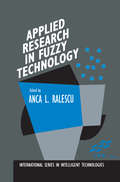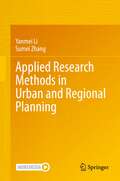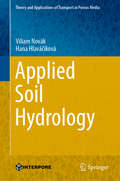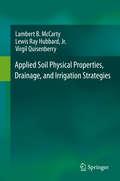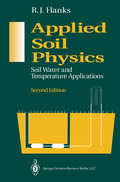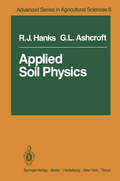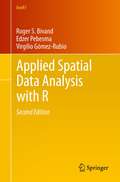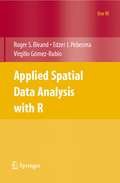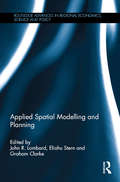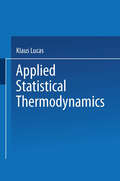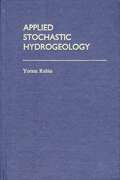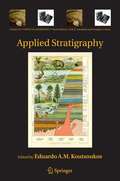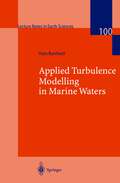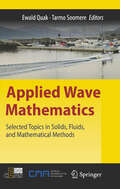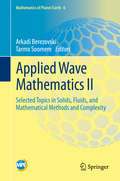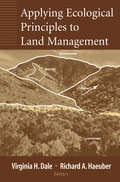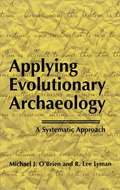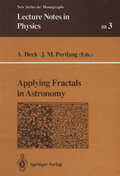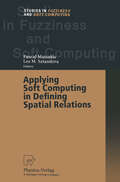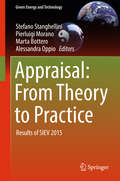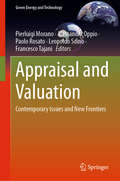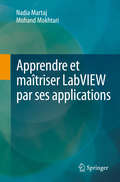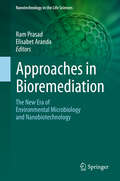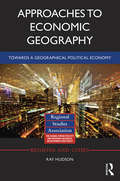- Table View
- List View
Applied Research in Fuzzy Technology: Three years of research at the Laboratory for International Fuzzy Engineering (LIFE), Yokohama, Japan (International Series in Intelligent Technologies #1)
by A. L. RalescuFuzzy logic is `a recent revolutionary technology' which has brought together researchers from mathematics, engineering, computer science, cognitive and behavioral sciences, etc. The work in fuzzy technology at the Laboratory for International Fuzzy Engineering (LIFE) has been specifically applied to engineering problems. This book reflects the results of the work that has been undertaken at LIFE with chapters treating the following topical areas: Decision Support Systems, Intelligent Plant Operations Support, Fuzzy Modeling and Process Control, System Design, Image Understanding, Behavior Decisions for Mobile Robots, the Fuzzy Computer, and Fuzzy Neuro Systems. The book is a thorough analysis of research which has been implemented in the areas of fuzzy engineering technology. The analysis can be used to improve these specific applications or, perhaps more importantly, to investigate more sophisticated fuzzy control applications.
Applied Research Methods in Urban and Regional Planning
by Yanmei Li Sumei ZhangThis book introduces the fundamentals of research methods and how they apply to the discipline of urban and regional planning. Written at a level appropriate for upper-level undergraduate and beginning master’s level students, the text fills a gap in the literature for textbooks on urban planning. Additionally, the book can be used as a reference for planning practitioners and researchers when analyzing quantitative and qualitative data in urban and regional planning and related fields.The volume does not assume advanced knowledge of mathematical formulas. Rather, it begins with the essentials of research methods, such as the identification of the research problems in planning, the literature review, data collection and presentation, descriptive data analysis, and report of findings. Its discipline-specific topics include field research methods, qualitative data analysis, economic and demographic analysis, evaluation research, and methods in sub-disciplines such as land use planning, transportation planning, environmental planning, and housing analysis. Designed with instruction in mind, this book features downloadable materials, including learning outcomes, chapter highlights, chapter review questions, datasets, and certain Excel models. Students will be able to download review questions to enhance the learning process and datasets to practice methods.
Applied Soil Hydrology (Theory and Applications of Transport in Porous Media #32)
by Viliam Novák Hana HlaváčikováThis state-of-the-art book clearly explains the basic principles of soil hydrology and the current knowledge in this field. It particularly highlights the estimation and application of measurements and evaluation of soil-hydrophysical characteristics using simulation models, with a focus on elucidating the basic hydrophysical characteristics of soil, such as soil water potential and hydraulic conductivity, as well as the methods of measurement. It also addresses topics such as stony soil, water repellent soils, and water movement modeling in those media. The book presents soil hydrology in a simple way, while quantitatively expressing the soil water state and movement. It clearly and precisely describes basic terms of soil hydrology with a minimum of mathematics. It also includes the latest research findings in the field as well as the basics of the mathematical modeling of water movement in the soil-plant-atmosphere system (SPAS), using original research results to illustrate these issues.This book is of interest to all scientists and professionals in soil hydrology, including beginners, as well as those interested and working in hydrology in general and soil hydrology in particular. In addition, it can also be used by specialists and students in related fields like agronomy, forestry, meteorology, hydrology, environmental engineering, environmental protection, and geography.
Applied Soil Physical Properties, Drainage, and Irrigation Strategies.
by Lambert B. McCarty Lewis Ray Hubbard, Jr. Virgil QuisenberryThe book is a realistic blend of basic knowledge and understanding in soil physical properties. It will enable the reader to scientifically analyze soils to develop practical and successful means of providing sufficient drainage and to develop science-based irrigation strategies. Only basic mathematical knowledge is necessary to understand and apply the proven principles covered. With limited resources that are increasing significantly in costs, the book blends the ideal concept of providing sufficient drainage and irrigation based on using soil physical properties but with financial limitations in mind. One traditional problem with many Soil Physics, Drainage, and Irrigations-based texts is the prerequisite of understanding complicated calculus-based mathematics. Although necessary for a theory-based text, our text was developed with practitioners in mind where such complicated mathematics was avoided but referenced if the reader wishes to further explore the specific topic. Another problem with many traditional texts is the lack of practical examples or case-studies allowing readers to relate their specific scenarios to similar types of situations. We have purposely included numerous examples and practical field experiences. This is especially true when many of the theoretical ideals are covered, followed by explanations of how such ideals can be applied in the laboratory and field.
Applied Soil Physics: Soil Water and Temperature Applications (Advanced Series in Agricultural Sciences #8)
by R.J. HanksThis second edition was undertaken to update information which has become available since the first edition and to convert completely to the SI system. The main objective of this book is to stress application of soil physics principles to real problems. The problems are heavily oriented toward the soil water-plant-atmosphere continuum. This book grew out of a course taught to upper level undergraduate and graduate students from many different disciplines and backgrounds. I have found that problems are a very good teaching tool because students need to solve them on their own and adapt them to their own understanding. I have found this problem-solving experience to be greatly enhanced if examples are available. Thus, this book is heavily laden with examples. This edition includes reference to many models, involving basic concepts discussed herein, by which it is possible to solve many more realistic--and more complex--problems such as drainage below the root zone (and associated pollution), plant growth as related to climate, soil properties, management, etc. The intent is to encourage students to advance to the next level. The book is not intended to be a complete introduction to applied soil physics, but rather to emphasize problem-solving and the important aspects of soil water and temperature.
Applied Soil Physics: Soil Water and Temperature Applications (Advanced Series in Agricultural Sciences #8)
by R. J. Hanks G. L. AshcroftApplied Spatial Data Analysis with R (Use R! #10)
by Roger S. Bivand Edzer Pebesma Virgilio Gómez-RubioApplied Spatial Data Analysis with R, second edition, is divided into two basic parts, the first presenting R packages, functions, classes and methods for handling spatial data. This part is of interest to users who need to access and visualise spatial data. Data import and export for many file formats for spatial data are covered in detail, as is the interface between R and the open source GRASS GIS and the handling of spatio-temporal data. The second part showcases more specialised kinds of spatial data analysis, including spatial point pattern analysis, interpolation and geostatistics, areal data analysis and disease mapping. The coverage of methods of spatial data analysis ranges from standard techniques to new developments, and the examples used are largely taken from the spatial statistics literature. All the examples can be run using R contributed packages available from the CRAN website, with code and additional data sets from the book's own website. Compared to the first edition, the second edition covers the more systematic approach towards handling spatial data in R, as well as a number of important and widely used CRAN packages that have appeared since the first edition. This book will be of interest to researchers who intend to use R to handle, visualise, and analyse spatial data. It will also be of interest to spatial data analysts who do not use R, but who are interested in practical aspects of implementing software for spatial data analysis. It is a suitable companion book for introductory spatial statistics courses and for applied methods courses in a wide range of subjects using spatial data, including human and physical geography, geographical information science and geoinformatics, the environmental sciences, ecology, public health and disease control, economics, public administration and political science. The book has a website where complete code examples, data sets, and other support material may be found: http://www.asdar-book.org. The authors have taken part in writing and maintaining software for spatial data handling and analysis with R in concert since 2003.
Applied Spatial Data Analysis with R (Use R!)
by Roger S. Bivand Edzer J. Pebesma Virgilio Gómez-RubioWe began writing this book in parallel with developing software for handling and analysing spatial data withR (R Development Core Team, 2008). - though the book is now complete, software development will continue, in the R community fashion, of rich and satisfying interaction with users around the world, of rapid releases to resolve problems, and of the usual joys and frust- tions of getting things done. There is little doubt that without pressure from users, the development ofR would not have reached its present scale, and the same applies to analysing spatial data analysis withR. It would, however, not be su?cient to describe the development of the R project mainly in terms of narrowly de?ned utility. In addition to being a communityprojectconcernedwiththedevelopmentofworld-classdataana- sis software implementations, it promotes speci?c choices with regard to how data analysis is carried out.R is open source not only because open source software development, including the dynamics of broad and inclusive user and developer communities, is arguably an attractive and successful development model.
Applied Spatial Modelling and Planning (Routledge Advances in Regional Economics, Science and Policy)
by John R. Lombard, Eliahu Stern and Graham ClarkeThis book highlights the extraordinary range of areas to which geographical analysis and spatial modelling can bring lessons and insights. It shows how these techniques have been used to address ‘real world’ issues that are of concern to international organisations, public agencies and businesses, as illustrated by actual funded projects that geographers have developed collaboratively with end-users. Applied Spatial Modelling and Planning shows how much geographical research is policy relevant to a wide variety of agencies through the use of GIS and spatial modelling in applied geography. The book’s chapters contain a cross-section of innovative applications and approaches to problem solving within five major domains of the dynamics of economic space, housing and settlements, population movements and population ageing, health care, and the environment. Using a number of case studies on the use of GIS and spatial modelling, this book demonstrates the fact that much of what is done by quantitative geographers is not only relevant within academia, but also has use in policy work. This book will appeal to an international audience interested in cutting-edge spatial modelling to better understand the processes involved in solving real problems.
Applied Spatial Modelling and Planning (Routledge Advances in Regional Economics, Science and Policy)
by John R. Lombard Eliahu Stern Graham ClarkeThis book highlights the extraordinary range of areas to which geographical analysis and spatial modelling can bring lessons and insights. It shows how these techniques have been used to address ‘real world’ issues that are of concern to international organisations, public agencies and businesses, as illustrated by actual funded projects that geographers have developed collaboratively with end-users. Applied Spatial Modelling and Planning shows how much geographical research is policy relevant to a wide variety of agencies through the use of GIS and spatial modelling in applied geography. The book’s chapters contain a cross-section of innovative applications and approaches to problem solving within five major domains of the dynamics of economic space, housing and settlements, population movements and population ageing, health care, and the environment. Using a number of case studies on the use of GIS and spatial modelling, this book demonstrates the fact that much of what is done by quantitative geographers is not only relevant within academia, but also has use in policy work. This book will appeal to an international audience interested in cutting-edge spatial modelling to better understand the processes involved in solving real problems.
Applied Statistical Thermodynamics
by Klaus LucasThe book guides the reader from the foundations of statisti- cal thermodynamics including the theory of intermolecular forces to modern computer-aided applications in chemical en- gineering and physical chemistry. The approach is new. The foundations of quantum and statistical mechanics are presen- ted in a simple way and their applications to the prediction of fluid phase behavior of real systems are demonstrated. A particular effort is made to introduce the reader to expli- cit formulations of intermolecular interaction models and to show how these models influence the properties of fluid sy- stems. The established methods of statistical mechanics - computer simulation, perturbation theory, and numerical in- tegration - are discussed in a style appropriate for newcom- ers and are extensively applied. Numerous worked examples illustrate how practical calculations should be carried out.
Applied Stochastic Hydrogeology
by Yoram RubinStochastic Subsurface Hydrogeology is the study of subsurface, geological heterogeneity, and its effects on flow and transport process, using probabilistic and geostatistical concepts. This book presents a rational, systematic approach for analyzing and modeling subsurface heterogeneity, and for modeling flow and transport in the subsurface, and for prediction and decision-making under uncertainty. The book covers the fundamentals and practical aspects of geostatistics and stochastic hydrogeology, coupling theoretical and practical aspects, with examples, case studies and guidelines for applications, and provides a summary and review of the major developments in these areas.
Applied Stratigraphy (Topics in Geobiology #23)
by Eduardo A. M. KoutsoukosStratigraphy has come to be indispensable to nearly all branches of the earth sciences, assisting such endeavors as charting the course of evolution, understanding ancient ecosystems, and furnishing data pivotal to finding strategic mineral resources. This book focuses on traditional and innovative stratigraphy techniques and how these can be used to reconstruct the geological history of sedimentary basins and in solving manifold geological problems and phenomena.
Applied Turbulence Modelling in Marine Waters (Lecture Notes in Earth Sciences #100)
by Hans BurchardThe simulation of turbulent mixing processes in marine waters is one of the most pressing tasks in oceanography. It is rendered difficult by the various complex phenomena occurring in these waters like strong stratification, ex ternal and internal waves, wind generated turbulence, Langmuir circulation etc. The need for simulation methods is especially great in this area because the physical processes cannot be investigated in the laboratory. Tradition ally, empirical bulk type models were used in oceanography, which, however, cannot account for many of the complex physical phenomena occurring. In engineering, statistical turbulence models describing locally the turbulence mixing processes were introduced in the early seventies, such as the k E model which is still one of the most widely used models in Computational Fluid Dy namics. Soon after, turbulence models were applied more and more also in the atmospheric sciences, and here the k kL model of Mellor and Yamada became particularly popular. In oceanography, statistical turbulence mod els were introduced rather late, i. e. in the eighties, and mainly models were taken over from the fields mentioned above, with some adjustments to the problems occurring in marine waters. In the literature on turbulence model applications to oceanography problems controversial findings and claims are reported about the various models, creating also an uncertainty on how well the models work in marine water problems.
Applied Wave Mathematics: Selected Topics in Solids, Fluids, and Mathematical Methods
by Ewald Quak Tarmo SoomereThis edited volume consists of twelve contributions related to the EU Marie Curie Transfer of Knowledge Project Cooperation of Estonian and Norwegian Scienti c Centres within Mathematics and its Applications, CENS-CMA (2005-2009), - der contract MTKD-CT-2004-013909, which ?nanced exchange visits to and from CENS, the Centre for Nonlinear Studies at the Institute of Cybernetics of Tallinn University of Technology in Estonia. Seven contributions describe research highlights of CENS members, two the work of members of CMA, the Centre of Mathematics for Applications,Univ- sity of Oslo, Norway, as the partner institution of CENS in the Marie Curie project, and three the ?eld of work of foreign research fellows, who visited CENS as part of theproject. Thestructureofthebookre?ectsthedistributionofthetopicsaddressed: Part I Waves in Solids Part II Mesoscopic Theory Part III Exploiting the Dissipation Inequality Part IV Waves in Fluids Part V Mathematical Methods The papers are written in a tutorial style, intended for non-specialist researchers and students, where the authors communicate their own experiences in tackling a problem that is currently of interest in the scienti?c community. The goal was to produce a book, which highlights the importance of applied mathematics and which can be used for educational purposes, such as material for a course or a seminar. To ensure the scienti?c quality of the contributions, each paper was carefully - viewed by two international experts. Special thanks go to all authors and referees, without whom making this book would not have been possible.
Applied Wave Mathematics II: Selected Topics in Solids, Fluids, and Mathematical Methods and Complexity (Mathematics of Planet Earth #6)
This book gathers contributions on various aspects of the theory and applications of linear and nonlinear waves and associated phenomena, as well as approaches developed in a global partnership of researchers with the national Centre of Excellence in Nonlinear Studies (CENS) at the Department of Cybernetics of Tallinn University of Technology in Estonia.The papers chiefly focus on the role of mathematics in the analysis of wave phenomena. They highlight the complexity of related topics concerning wave generation, propagation, transformation and impact in solids, gases, fluids and human tissues, while also sharing insights into selected mathematical methods for the analytical and numerical treatment of complex phenomena. In addition, the contributions derive advanced mathematical models, share innovative ideas on computing, and present novel applications for a number of research fields where both linear and nonlinear wave problems play an important role.The papers are written in a tutorial style, intended for non-specialist researchers and students. The authors first describe the basics of a problem that is currently of interest in the scientific community, discuss the state of the art in related research, and then share their own experiences in tackling the problem.Each chapter highlights the importance of applied mathematics for central issues in the study of waves and associated complex phenomena in different media. The topics range from basic principles of wave mechanics up to the mathematics of Planet Earth in the broadest sense, including contemporary challenges in the mathematics of society. In turn, the areas of application range from classic ocean wave mathematics to material science, and to human nerves and tissues. All contributions describe the approaches in a straightforward manner, making them ideal material for educational purposes, e.g. for courses, master class lectures, or seminar presentations.
Applying Ecological Principles to Land Management
by Virginia H. Dale R. T. T. Forman Richard A. HaeuberThis volume incorporates case studies that explore past and current land use decisions on both public and private lands, and includes practical approaches and tools for land use decision-making. The most important feature of the book is the linking of ecological theory and principle with applied land use decision-making. The theoretical and empirical are joined through concrete case studies of actual land use decision-making processes.
Applying Evolutionary Archaeology: A Systematic Approach
by Michael J. O'Brien R. Lee LymanAnthropology, and by extension archaeology, has had a long-standing interest in evolution in one or several of its various guises. Pick up any lengthy treatise on humankind written in the last quarter of the nineteenth century and the chances are good that the word evolution will appear somewhere in the text. If for some reason the word itself is absent, the odds are excellent that at least the concept of change over time will have a central role in the discussion. After one of the preeminent (and often vilified) social scientists of the nineteenth century, Herbert Spencer, popularized the term in the 1850s, evolution became more or less a household word, usually being used synonymously with change, albeit change over extended periods of time. Later, through the writings of Edward Burnett Tylor, Lewis Henry Morgan, and others, the notion of evolution as it applies to stages of social and political development assumed a prominent position in anthropological disc- sions. To those with only a passing knowledge of American anthropology, it often appears that evolutionism in the early twentieth century went into a decline at the hands of Franz Boas and those of similar outlook, often termed particularists. However, it was not evolutionism that was under attack but rather comparativism— an approach that used the ethnographic present as a key to understanding how and why past peoples lived the way they did (Boas 1896).
Applying Fractals in Astronomy (Lecture Notes in Physics Monographs #3)
by Andre Heck Jean M. Perdang'Fractal geometry addressesitselfto questions that many people have been asking themselves. It con cerns an aspect of Nature that almost everybody had been conscious of, but could not address in a formal fashion. ' 'Fractal geometry seems to be the proper language to describe the complezity of many very compli cated shapes around us. ' (Mandelbrot, 1990a) 'I believe that fractals respond to a profound un easiness in man. ' (Mandelbrot, 1990b) The catchword fractal, ever since it was coined by Mandelbrot (1975) to refer to a class of abstract mathematical objects that were already known at the turn ofthe 19th century, has found an unprecedented resonance both inside and outside the scientific community. Fractal concepts, far more than the concepts of catastrophe theory introduced a few years earlier, are currently being applied not only in the physical sciences, but also in biology and medicine (Goldberger and West 1987). In the mid-eighties, Kadanoff (1986) asked the question: 'Why all the fuss about /ractals'! '. He offered a twofold answer: in the first place, it is 'because of the practical, technological importance of fractal objects'. Indeed he emphasised the relevance of these structures for materials scientists and oil drilling engineers, in search of structures with novel properties, or models for the flow of oil through the soil. His second answer was: 'Because of the intellectual interest of fractals '.
Applying Soft Computing in Defining Spatial Relations (Studies in Fuzziness and Soft Computing #106)
by Pascal Matsakis Les M. SztanderaGeometric properties and relations play central roles in the description and processing of spatial data. The properties and relations studied by mathematicians usually have precise definitions, but verbal descriptions often involve imprecisely defined concepts such as elongatedness or proximity. The methods used in soft computing provide a framework for formulating and manipulating such concepts. This volume contains eight papers on the soft definition and manipulation of spatial relations and gives a comprehensive summary on the subject.
Appraisal: Results of SIEV 2015 (Green Energy and Technology)
by Stefano Stanghellini Pierluigi Morano Marta Bottero Alessandra OppioThis book documents the state of the art and the emerging operational perspectives in the field of the appraisal discipline. It covers a wide range of topics, including energy efficiency, environmental sustainability, socio-economic evaluation of regional and urban transformations, real estate and facility management, risk management. It also discusses the potential role of appraisal in minimising unexpected consequences; the role of evaluators in urban development projects as well as the contribution of several methodologies with respect to the overall planning and design processes; the need to manage the complexity of the current decision contexts, while at the same time promoting efficient and effective evaluation processes; improving the quality of discussion and communication of the outcomes of evaluation processes; as well as the appropriateness of current regulation and policy regimes (EU, national, regional etc.). It comprises a selection of the best papers presented at the SIEV 2015 conference "Appraisal: Current Issues and Problems", which was held in Bari, Italy, in July 2015, and brought together architects, engineers, urban planners, decision-makers and government representatives.
Appraisal and Valuation: Contemporary Issues and New Frontiers (Green Energy and Technology)
by Pierluigi Morano Alessandra Oppio Paolo Rosato Leopoldo Sdino Francesco TajaniThis book features a selection of the best papers presented at two recent conferences organized by the SIEV (Italian Society of Appraisal and Valuation). Taking into account the current need for evaluative skills in order to make effective and sustainable investments, it highlights the multidisciplinary role of valuation, which opens the door for interactions with other sectors, scientific and professional fields. The book collects twenty-two papers, divided into three parts (Territory & Urban Planning, Real Estate Assets & the Construction Building Process, Real Estate Finance & Property Management) that reflect the main issues of interest for future urban development policies, namely: feasibility analysis for investments; selecting which decision support models to apply in complex contexts; enhancement of public and private assets; evaluating the effects produced by territorial investments; valuation approaches to properties; risk assessment; and strategies for monitoring energy consumption and soil sealing.
Apprendre et maîtriser LabVIEW par ses applications
by Nadia Martaj Mohand MokhtariCet ouvrage traite de l’apprentissage du langage LabVIEW à travers ses applications dans des domaines industriels et académiques, qui permettront à l’ingénieur, technicien ou étudiant d’appréhender rapidement et efficacement ce langage. L’ouvrage commence, dans la partie I, par traiter les différents types de données du langage LabVIEW (tableaux, clusters, complexes, chaînes de caractères…), leur manipulation dans des structures d’exécution (boucles While, For, la structure Condition, etc.), le langage textuel MathScript, des scripts Matlab, la boîte de calcul utilisant la syntaxe du langage C ainsi que les nœuds de propriété qui permettent d’obtenir ou définir la propriété d'un VI. Cette étude est menée à travers des applications d’ingénierie.La partie II est consacrée à l’étude de l’outil « Conception de contrôle et simulation » avec lequel nous pouvons simuler des systèmes analogiques ou discrets.La partie III contient différentes applications qui traitent de nombreux thèmes comme la régulation (différentes structures du PID, les commandes RST, LQI, etc.), la logique floue, le traitement de signal (déterministe, aléatoire et filtrage adaptatif, etc.), le traitement des fichiers de mesure, la statistique expérimentale, etc.
Approaches in Bioremediation: The New Era of Environmental Microbiology and Nanobiotechnology (Nanotechnology in the Life Sciences)
by Ram Prasad Elisabet ArandaBioremediation refers to the clean‐up of pollution in soil, groundwater, surface water, and air using typically microbiological processes. It uses naturally occurring bacteria and fungi or plants to degrade, transform or detoxify hazardous substances to human health or the environment.For bioremediation to be effective, microorganisms must enzymatically attack the pollutants and convert them to harmless products. As bioremediation can be effective only where environmental conditions permit microbial growth and action, its application often involves the management of ecological factors to allow microbial growth and degradation to continue at a faster rate. Like other technologies, bioremediation has its limitations. Some contaminants, such as chlorinated organic or high aromatic hydrocarbons, are resistant to microbial attack. They are degraded either gradually or not at all, hence, it is not easy to envisage the rates of clean-up for bioremediation implementation.Bioremediation represents a field of great expansion due to the important development of new technologies. Among them, several decades on metagenomics expansion has led to the detection of autochthonous microbiota that plays a key role during transformation. Transcriptomic guides us to know the expression of key genes and proteomics allow the characterization of proteins that conduct specific reactions. In this book we show specific technologies applied in bioremediation of main interest for research in the field, with special attention on fungi, which have been poorly studied microorganisms. Finally, new approaches in the field, such as CRISPR-CAS9, are also discussed. Lastly, it introduces management strategies, such as bioremediation application for managing affected environment and bioremediation approaches. Examples of successful bioremediation applications are illustrated in radionuclide entrapment and retardation, soil stabilization and remediation of polycyclic aromatic hydrocarbons, phenols, plastics or fluorinated compounds. Other emerging bioremediation methods include electro bioremediation, microbe-availed phytoremediation, genetic recombinant technologies in enhancing plants in accumulation of inorganic metals, and metalloids as well as degradation of organic pollutants, protein-metabolic engineering to increase bioremediation efficiency, including nanotechnology applications are also discussed.
Approaches to Economic Geography: Towards a geographical political economy (Regions and Cities)
by Ray HudsonThe last four decades have seen major changes in the global economy, with the collapse of communism and the spread of capitalism into parts of the world from which it had previously been excluded. Beginning with a grounding in Marxian political economy, this book explores a range of new ideas as to what economic geography can offer as it intersects with public policy and planning in the new globalised economy. Approaches to Economic Geography draws together the formidable work of Ray Hudson into an authoritative collection, offering a unique approach to the understanding of the changing geographies of the global economy. With chapters covering subjects ranging from uneven development to social economy, this volume explores how a range of perspectives, including evolutionary and institutional approaches, can further elucidate how such economies and their geographies are reproduced. Subsequent chapters argue that greater attention must be given to the relationships between the economy and nature, and that more consideration needs to be given to the growing significance of illegal activities in the economy. The book will be of interest to students studying economic geography as well as researchers and policy makers that recognise the importance of the relationships between economy and geography as we move towards a sustainable future economy and society.
